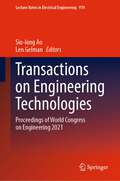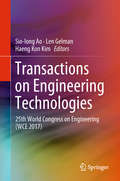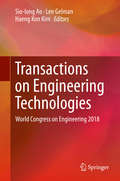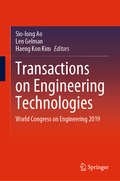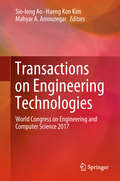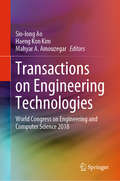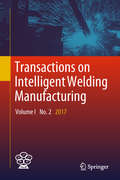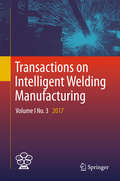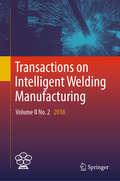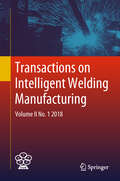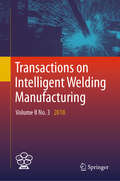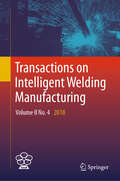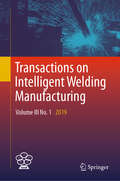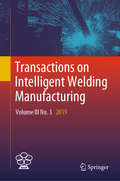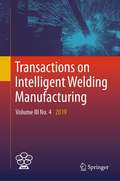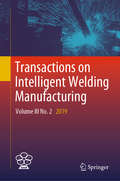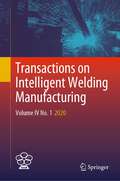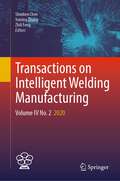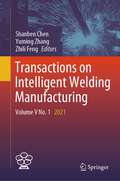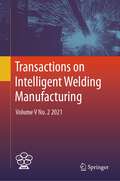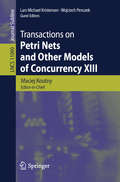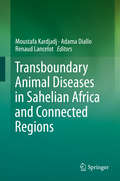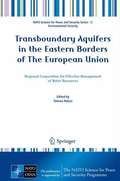- Table View
- List View
Transactions on Engineering Technologies: Proceedings of World Congress on Engineering 2021 (Lecture Notes in Electrical Engineering #919)
by Sio-Iong Ao Len GelmanThis book contains a selection of revised and extended research articles written by prominent researchers participating in the international conference on Advances in Engineering Technologies and Physical Science is held in London, UK, during July 7–9, 2021. This book demonstrates revised and extended research articles written by prominent researchers participating in the conference. Topics covered include mechanical engineering, bioengineering, Internet engineering, image engineering, wireless networks, knowledge engineering, manufacturing engineering, and industrial applications. The book offers the state of the art of tremendous advances in engineering technologies and physical science and applications and also serves as an excellent reference work for researchers and graduate students working with/on engineering technologies and physical science and applications.
Transactions on Engineering Technologies: Special Volume Of The World Congress On Engineering 2013 (Lecture Notes In Electrical Engineering #275)
by Sio-Iong Ao Len Gelman Haeng Kon KimThis volume contains a selection of revised and extended research articles written by prominent researchers participating in a large international conference on Advances in Engineering Technologies and Physical Science which was held in London, UK, 5-7 July, 2017. Topics covered include mechanical engineering, engineering mathematics, computer science, knowledge engineering, electrical engineering, wireless networks, and industrial applications. With contributions carefully chosen to represent the most cutting-edge research presented during the conference, the book offers the state of art in engineering technologies and physical science and applications, and also serves as an excellent reference work for researchers and graduate students working with/on engineering technologies and physical science and applications.
Transactions on Engineering Technologies: World Congress on Engineering 2018 (Lecture Notes In Electrical Engineering Ser. #275)
by Sio-Iong Ao Len Gelman Haeng Kon KimThis volume contains a selection of revised and extended research articles written by prominent researchers participating in The 26th World Congress on Engineering (WCE 2018) which was held in London, U.K., July 4-6, 2018. Topics covered include engineering mathematics, electrical engineering, communications systems, computer science, chemical engineering, systems engineering, manufacturing engineering, and industrial applications. With contributions carefully chosen to represent the most cutting-edge research presented during the conference, the book contains some of the state-of-the-art in engineering technologies and the physical sciences and their applications, and serves as a useful reference for researchers and graduate students working in these fields.
Transactions on Engineering Technologies: World Congress on Engineering 2019 (Lecture Notes In Electrical Engineering Ser. #275)
by Sio-Iong Ao Len Gelman Haeng Kon KimThis book contains a selection of research articles written by prominent researchers participating in The 27th World Congress on Engineering (WCE 2019) which was held in London, UK, July 3–5, 2019. Topics covered include engineering mathematics, electrical engineering, communications systems, computer science, chemical engineering, systems engineering, manufacturing engineering, and industrial applications. With contributions carefully chosen to represent the most cutting-edge research presented during the conference, the book contains some of the state of the art in engineering technologies and the physical sciences and their applications and serves as a useful reference for researchers and graduate students working in these fields.
Transactions on Engineering Technologies: World Congress on Engineering and Computer Science 2017 (Lecture Notes In Electrical Engineering #275)
by Sio-Iong Ao Haeng Kon Kim Mahyar A. AmouzegarThis volume contains a selection of revised and extended research articles written by prominent researchers participating in a large international conference on Advances in Engineering Technologies and Physical Science which was held in San Francisco, California, USA, October 25-27, 2017. Topics covered include engineering mathematics, electrical engineering, communications systems, computer science, chemical engineering, systems engineering, manufacturing engineering, and industrial applications. With contributions carefully chosen to represent the most cutting-edge research presented during the conference, the book contains some of the state-of-the-art in engineering technologies and the physical sciences and their applications, and serves as a useful reference for researchers and graduate students working in these fields.
Transactions on Engineering Technologies: World Congress on Engineering and Computer Science 2018 (Lecture Notes In Electrical Engineering Ser. #275)
by Sio-Iong Ao Haeng Kon Kim Mahyar A. AmouzegarThis book features a selection of revised and extended research articles written by prominent researchers who participated in the 26th World Congress on Engineering and Computer Science (WCECS 2018), held in San Francisco, USA, on October 23–25, 2018. Topics covered include engineering mathematics, electrical engineering, communications systems, computer science, chemical engineering, systems engineering, manufacturing engineering and industrial applications. With contributions carefully chosen to represent the most cutting-edge research presented at the conference and highlighting the state of the art in engineering technologies and the physical sciences and their applications, the book is a valuable reference resource for graduate students and researchers working in these fields.
Transactions on Engineering Technologies: World Congress on Engineering and Computer Science 2019 (Lecture Notes In Electrical Engineering Ser. #275)
by Sio-Iong Ao Mahyar A. Amouzegar Haeng-Kon KimThis book contains a selection of revised and extended research articles written by prominent researchers participating in the 27th World Congress on Engineering and Computer Science (WCECS 2019) which was held in San Francisco, USA, on October 22–24, 2019. Topics covered include engineering mathematics, electrical engineering, communications systems, computer science, chemical engineering, systems engineering, manufacturing engineering, and industrial applications. With contributions carefully chosen to represent the most cutting-edge research presented during the conference, the book contains some of the state-of-the-art in engineering technologies and the physical sciences and their applications and serves as a useful reference for researchers and graduate students working in these fields.
Transactions on Intelligent Welding Manufacturing
by Shanben Chen Yuming Zhang Zhili FengThe primary aim of this volume is to provide researchers and engineers from both academia and industry with up-to-date coverage of recent advances in the fields of robotic welding, intelligent systems and automation. It gathers selected papers from the 2017 International Workshop on Intelligentized Welding Manufacturing (IWIWM'2017), held June 23-26, 2017 in Shanghai, China. The contributions reveal how intelligentized welding manufacturing (IWM) is becoming an inescapable trend, just as intelligentized robotic welding is becoming a key technology. The volume is divided into four main parts: Intelligent Techniques for Robotic Welding, Sensing in Arc Welding Processing, Modeling and Intelligent Control of Welding Processing, and Intelligent Control and its Applications in Engineering.
Transactions on Intelligent Welding Manufacturing: Volume I No. 1 2017 (Transactions on Intelligent Welding Manufacturing)
by Shanben Chen Yuming Zhang Zhili FengThe primary aim of this volume is to provide researchers and engineers from both academia and industry with up-to-date coverage of recent advances in the fields of robotic welding, intelligent systems and automation. It gathers selected papers from the 2017 International Workshop on Intelligentized Welding Manufacturing (IWIWM’2017), held June 23-26, 2017 in Shanghai, China. The contributions reveal how intelligentized welding manufacturing (IWM) is becoming an inescapable trend, just as intelligentized robotic welding is becoming a key technology. The volume is divided into four main parts: Intelligent Techniques for Robotic Welding, Sensing in Arc Welding Processing, Modeling and Intelligent Control of Welding Processing, and Intelligent Control and its Applications in Engineering.
Transactions on Intelligent Welding Manufacturing: Volume I No. 1 2017 (Transactions on Intelligent Welding Manufacturing)
by Shanben Chen Yuming Zhang Zhili FengThe primary aim of this volume is to provide researchers and engineers from both academia and industry with up-to-date coverage of recent advances in the fields of robotic welding, intelligent systems and automation. It gathers selected papers from the 2018 International Conference on Robotic Welding, Intelligence and Automation (RWIA 2018), held Oct 20-22, 2018 in Guangzhou, China. The contributions reveal how intelligentized welding manufacturing (IWM) is becoming an inescapable trend, just as intelligentized robotic welding is becoming a key technology. The volume is divided into four main parts: Intelligent Techniques for Robotic Welding, Sensing in Arc Welding Processing, Modeling and Intelligent Control of Welding Processing, and Intelligent Control and its Applications in Engineering.
Transactions on Intelligent Welding Manufacturing: Volume II No. 1 2018 (Transactions on Intelligent Welding Manufacturing)
by Shanben Chen Yuming Zhang Zhili FengThe primary aim of this volume is to provide researchers and engineers from both academia and industry with up-to-date coverage of recent advances in the fields of robotic welding, intelligent systems and automation. It gathers selected papers from the 2018 International Conference on Robotic Welding, Intelligence and Automation (RWIA 2018), held Oct 20-22, 2018 in Guangzhou, China. The contributions reveal how intelligentized welding manufacturing (IWM) is becoming an inescapable trend, just as intelligentized robotic welding is becoming a key technology. The volume is divided into four main parts: Intelligent Techniques for Robotic Welding, Sensing in Arc Welding Processing, Modeling and Intelligent Control of Welding Processing, and Intelligent Control and its Applications in Engineering.
Transactions on Intelligent Welding Manufacturing: Volume II No. 3 2018 (Transactions on Intelligent Welding Manufacturing)
by Shanben Chen Yuming Zhang Zhili FengThe primary aim of this volume is to provide researchers and engineers from both academia and industry with up-to-date coverage of recent advances in the fields of robotic welding, intelligent systems and automation. It gathers selected papers from the 2018 International Conference on Robotic Welding, Intelligence and Automation (RWIA 2018), held Oct 20-22, 2018 in Guangzhou, China. The contributions reveal how intelligentized welding manufacturing (IWM) is becoming an inescapable trend, just as intelligentized robotic welding is becoming a key technology. The volume is divided into four main parts: Intelligent Techniques for Robotic Welding, Sensing in Arc Welding Processing, Modeling and Intelligent Control of Welding Processing, and Intelligent Control and its Applications in Engineering.
Transactions on Intelligent Welding Manufacturing: Volume II No. 4 2018 (Transactions on Intelligent Welding Manufacturing)
by Shanben Chen Yuming Zhang Zhili FengThe primary aim of this volume is to provide researchers and engineers from both academia and industry with up-to-date coverage of recent advances in the fields of robotic welding, intelligent systems and automation. It gathers selected papers from the 2018 International Conference on Robotic Welding, Intelligence and Automation (RWIA 2018), held Oct 20-22, 2018 in Guangzhou, China. The contributions reveal how intelligentized welding manufacturing (IWM) is becoming an inescapable trend, just as intelligentized robotic welding is becoming a key technology. The volume is divided into four main parts: Intelligent Techniques for Robotic Welding, Sensing in Arc Welding Processing, Modeling and Intelligent Control of Welding Processing, and Intelligent Control and its Applications in Engineering.
Transactions on Intelligent Welding Manufacturing: Volume III No. 1 2019 (Transactions on Intelligent Welding Manufacturing)
by Shanben Chen Yuming Zhang Zhili FengThe primary aim of this volume is to provide researchers and engineers from both academic and industry with up-to-date coverage of new results in the field of robotic welding, intelligent systems and automation. The book is mainly based on papers selected from the 2019 International Workshop on Intelligentized Welding Manufacturing (IWIWM’2019) in USA. The articles show that the intelligentized welding manufacturing (IWM) is becoming an inevitable trend with the intelligentized robotic welding as the key technology. The volume is divided into four logical parts: Intelligent Techniques for Robotic Welding, Sensing of Arc Welding Processing, Modeling and Intelligent Control of Welding Processing, as well as Intelligent Control and its Applications in Engineering.
Transactions on Intelligent Welding Manufacturing: Volume III No. 3 2019 (Transactions on Intelligent Welding Manufacturing)
by Shanben Chen Yuming Zhang Zhili FengThe primary aim of this volume is to provide researchers and engineers from both academic and industry with up-to-date coverage of new results in the field of robotic welding, intelligent systems and automation. The book is mainly based on papers selected from the 2019 International Workshop on Intelligentized Welding Manufacturing (IWIWM’2019) in USA. The articles show that the intelligentized welding manufacturing (IWM) is becoming an inevitable trend with the intelligentized robotic welding as the key technology. The volume is divided into four logical parts: Intelligent Techniques for Robotic Welding, Sensing of Arc Welding Processing, Modeling and Intelligent Control of Welding Processing, as well as Intelligent Control and its Applications in Engineering.
Transactions on Intelligent Welding Manufacturing: Volume III No. 4 2019 (Transactions on Intelligent Welding Manufacturing)
by Shanben Chen Yuming Zhang Zhili FengThe primary aim of this volume is to provide researchers and engineers from both academic and industry with up-to-date coverage of new results in the field of robotic welding, intelligent systems and automation. The book is mainly based on papers selected from the 2019 International Workshop on Intelligentized Welding Manufacturing (IWIWM’2019) in USA. The articles show that the intelligentized welding manufacturing (IWM) is becoming an inevitable trend with the intelligentized robotic welding as the key technology. The volume is divided into four logical parts: Intelligent Techniques for Robotic Welding, Sensing of Arc Welding Processing, Modeling and Intelligent Control of Welding Processing, as well as Intelligent Control and its Applications in Engineering.
Transactions on Intelligent Welding Manufacturing: Volume IV No. 1 2020 (Transactions on Intelligent Welding Manufacturing)
by Shanben Chen Yuming Zhang Zhili FengThe primary aim of this volume is to provide researchers and engineers from both academic and industry with up-to-date coverage of new results in the field of robotic welding, intelligent systems and automation. The book is mainly based on papers selected from the 2020 International Conference on Robotic Welding, Intelligence and Automation (RWIA’2020) in Shanghai and Lanzhou, China. The articles show that the intelligentized welding manufacturing (IWM) is becoming an inevitable trend with the intelligentized robotic welding as the key technology. The volume is divided into four logical parts: Intelligent Techniques for Robotic Welding, Sensing of Arc Welding Processing, Modeling and Intelligent Control of Welding Processing, as well as Intelligent Control and its Applications in Engineering.
Transactions on Intelligent Welding Manufacturing: Volume IV No. 1 2020 (Transactions on Intelligent Welding Manufacturing)
by Shanben Chen Yuming Zhang Zhili FengThe primary aim of this volume is to provide researchers and engineers from both academic and industry with up-to-date coverage of new results in the field of robotic welding, intelligent systems and automation. The book is mainly based on papers selected from the 2020 International Conference on Robotic Welding, Intelligence and Automation (RWIA’2020) in Shanghai and Lanzhou, China. The articles show that the intelligentized welding manufacturing (IWM) is becoming an inevitable trend with the intelligentized robotic welding as the key technology. The volume is divided into four logical parts: Intelligent Techniques for Robotic Welding, Sensing of Arc Welding Processing, Modeling and Intelligent Control of Welding Processing, as well as Intelligent Control and its Applications in Engineering.
Transactions on Intelligent Welding Manufacturing: Volume IV No. 2 2020 (Transactions on Intelligent Welding Manufacturing)
by Shanben Chen Yuming Zhang Zhili FengThe primary aim of this volume is to provide researchers and engineers from both academic and industry with up-to-date coverage of new results in the field of robotic welding, intelligent systems and automation. The book is mainly based on papers selected from the 2020 International Conference on Robotic Welding, Intelligence and Automation (RWIA’2020) in Shanghai and Lanzhou, China. The articles show that the intelligentized welding manufacturing (IWM) is becoming an inevitable trend with the intelligentized robotic welding as the key technology. The volume is divided into four logical parts: Intelligent Techniques for Robotic Welding, Sensing of Arc Welding Processing, Modeling and Intelligent Control of Welding Processing, as well as Intelligent Control and its Applications in Engineering.
Transactions on Intelligent Welding Manufacturing: Volume V No. 1 2021 (Transactions on Intelligent Welding Manufacturing)
by Shanben Chen Yuming Zhang Zhili FengThe primary aim of this book is to provide researchers and engineers from both academic and industry with up-to-date coverage of new results in the field of robotic welding, intelligent systems and automation. The book is mainly based on papers selected from the 2022 International Conference on Robotic Welding, Intelligence and Automation (RWIA’2022) in Shanghai and Lanzhou, China. The articles show that the intelligentized welding manufacturing (IWM) is becoming an inevitable trend with the intelligentized robotic welding as the key technology. The volume is divided into four logical parts: Intelligent Techniques for Robotic Welding, Sensing of Arc Welding Processing, Modeling and Intelligent Control of Welding Processing, as well as Intelligent Control and its Applications in Engineering.
Transactions on Intelligent Welding Manufacturing: Volume V No. 2 2021 (Transactions on Intelligent Welding Manufacturing)
by Shanben Chen Yuming Zhang Zhili FengThe primary aim of this volume is to provide researchers and engineers from both academic and industry with up-to-date coverage of new results in the field of robotic welding, intelligent systems and automation. The book is mainly based on papers selected from the 2022 International Conference on Robotic Welding, Intelligence and Automation (RWIA’2022) in Shanghai and Lanzhou, China. The articles show that the intelligentized welding manufacturing (IWM) is becoming an inevitable trend with the intelligentized robotic welding as the key technology. The volume is divided into four logical parts: Intelligent Techniques for Robotic Welding, Sensing of Arc Welding Processing, Modeling and Intelligent Control of Welding Processing, as well as Intelligent Control and its Applications in Engineering.
Transactions on Petri Nets and Other Models of Concurrency XIII (Lecture Notes in Computer Science #11090)
by Maciej Koutny Wojciech Penczek Lars Michael KristensenThe 13th volume of ToPNoC contains revised and extended versions of a selection of the best workshop papers presented at the 38th International Conference on Application and Theory of Petri Nets and Concurrency, Petri Nets 2017, and the 17th International Conference on Application of Concurrency to System Design, ACSD 2017. The 9 papers cover a diverse range of topics including model checking and system verification, refinement, and synthesis; foundational work on specific classes of Petri nets; and innovative applications of Petri nets and other models of concurrency. Application areas covered in this volume are: fault-tolerance, service composition, databases, communication protocols, business processes, and distributed systems. Thus, this volume gives a good overview of ongoing research on concurrent systems and Petri nets.
Transboundary Animal Diseases in Sahelian Africa and Connected Regions
by Renaud Lancelot Moustafa Kardjadj Adama DialloThis book primarily focuses on the African Sahel region, shedding new light on the epidemiology, socio-economics, clinical manifestations and control approaches of transboundary animal diseases (TADs) in this specific region. In addition to the description of TADs in Sahelian Africa and connected regions, several issues regarding the burden of TADs, the role of national/regional/international veterinary organizations in the surveillance process, animal mobility, one health and TADs in the dromedary are discussed. The book contains 22 chapters and is structured in three parts, i- general features and commonalities, ii- viral diseases, iii- bacterial diseases. Each chapter was written by a group of experts specialized in the topic. This work will be of general interest to researchers, veterinarians, veterinary public health officers, and students engaged in the surveillance and control of animal infectious diseases, included those of zoonotic nature and that are prevalent in the Sahel.
Transboundary Aquifers in the Eastern Borders of The European Union
by Tomasz NałęczThis book focuses on sustainable use and protection of transboundary aquifers located along the eastern border of European Union starting from the Baltic Sea and end in the Black Sea. The groundwater resources in this region play a very important role not only as a source of clean and safe drinking water, but also for social, economic and safety reasons. This publication sheds light on a wide range of real problems related to the management of groundwater, problems that are characteristic for most countries situated in the East European region. It also identifies potential threats that may materialise in the absence of cooperation between countries and appropriate measures to jointly manage the shared water resources in the region. Experience from some ongoing projects towards integrated management of transboundary aquifers (research, monitoring and data analysis) is reported. The book is addressed, in particular, to groundwater academics, researchers and experts as well as water management specialists interested in solving environmental issues extended to more than one country territory. On the other hand presented knowledge and experience would be also useful for decision makers especially to support environmental decision processes in border areas and work on preparation of international agreements on groundwater management.
Transboundary Aquifers in the Eastern Borders of The European Union: Regional Cooperation for Effective Management of Water Resources (NATO Science for Peace and Security Series C: Environmental Security)
by Tomasz NałęczThis book focuses on sustainable use and protection of transboundary aquifers located along the eastern border of European Union starting from the Baltic Sea and end in the Black Sea. The groundwater resources in this region play a very important role not only as a source of clean and safe drinking water, but also for social, economic and safety reasons. This publication sheds light on a wide range of real problems related to the management of groundwater, problems that are characteristic for most countries situated in the East European region. It also identifies potential threats that may materialise in the absence of cooperation between countries and appropriate measures to jointly manage the shared water resources in the region. Experience from some ongoing projects towards integrated management of transboundary aquifers (research, monitoring and data analysis) is reported. The book is addressed, in particular, to groundwater academics, researchers and experts as well as water management specialists interested in solving environmental issues extended to more than one country territory. On the other hand presented knowledge and experience would be also useful for decision makers especially to support environmental decision processes in border areas and work on preparation of international agreements on groundwater management.
